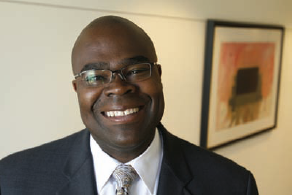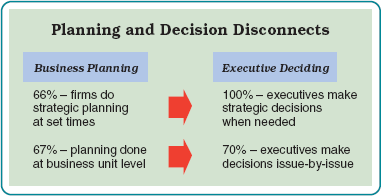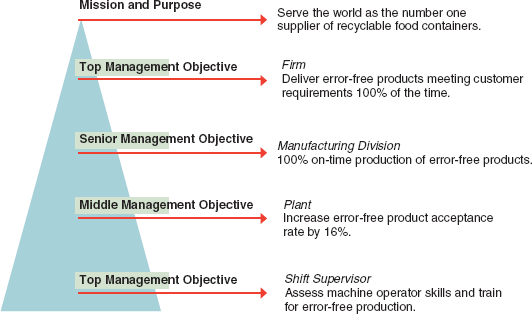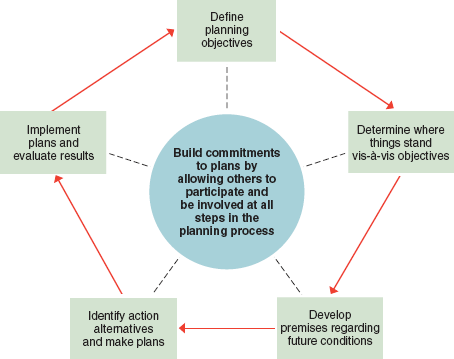Chapter 8 Study Questions
Why and how do managers plan?
What types of plans do managers use?
What are the useful planning tools and techniques?
How can plans be well implemented?
It's easy to get so engrossed in the present that we forget about the future. Yet a rush to the future can go off track without solid reference points in the past. The trick is to blend past experiences with future aspirations, and a willingness to adjust as new circumstances arise.
Oprah Winfrey is a media star, corporate executive, and popular personality. Having grown up poor, Oprah says that she is grateful for getting a good education, calling it "the most vital aspect of my life." She's sharing that lesson through the Oprah Winfrey Leadership Academy for young women in South Africa. At the opening ceremony she said: "I wanted to give this opportunity to girls who had a light so bright that not even poverty could dim that light." She also talked about her past, mentioning that she "was a poor girl who grew up with my grandmother, like so many of these girls, with no water and electricity." As to the goal, she stated that she wanted the new academy to "be the best school in the world."
Nelson Mandela, first president of non-apartheid South Africa, spoke at the opening ceremony and praised her vision. "The key to any country's future is in educating its youth," said Mandela. "Oprah is therefore not only investing in a few young individuals, but in the future of our country." One of the first students said: "I would have had a completely different life if this hadn't happened to me."
Yet even with the best intentions things don't always go according to plan. Not long after the academy launched, it was hit by scandal. One of the dorm matrons was arrested for abusing one of the students. Oprah apologized to the students and their families, and rededicated herself to the school. "I think that crisis is there to teach you about life," she said. "The school is going to be even better because that happened." And looking even further ahead, she hasn't stopped dreaming or planning—her intention is to build yet another school for both young men and women.[454]

"The best plans often go wrong." "The problem is with the details." We often hear these expressions. But Oprah's experience in South Africa also shows that you can make great things happen with good insight, the right plans, and proper controls. Even when things don't go as intended, plans and their implementation can often be adjusted to achieve important goals.
When it comes to planning, one of the first things that may come to mind is time. It is one of our most precious resources, and time management is an essential skill in today's high-pressure and fast-paced world. Some 77% of managers in one survey said that the new digital age has increased the number of decisions they have to make; 43% complained there was less time available to make them. Another report notes that interruptions steal 28% of the average worker's day.[455] And, who hasn't complained or heard others complaining about a need for more work-life balance?
Don't you wonder about the time you waste dealing with e-mail, instant messages, voice and text messages, drop-in visits from coworkers and friends, waiting on the phone for customer service, and more?
Of course, you have to be careful in defining "waste." It isn't a waste of time to occasionally relax, take a breather from work or daily affairs, and find humor and pleasure in social interactions. Such breaks help us gather and replenish energies to do well in our tasks. But it is a waste to let friends dominate your time so that you don't work on a term paper until it is too late to write a really good one, or delay a decision to apply for an internship until the deadline is passed.
Perhaps you are one of those who plan to do so many things in a day that you never get to the most important ones. Perhaps you hardly plan, letting events take you where they may. And perhaps on many days you end up not accomplishing much at all.
Learning to better manage your time can serve you very well in the future, both at work and in your personal life. Take a step forward in time management. Complete the lists requested in the boxed time management planner. Double-check all the List 1 "B" items. Reclassify any that are really "As" or "Cs." Look at your "As" and reclassify any that are really "Bs" or "Cs." Also check your time wasters in List 2. Make a commitment to take charge of the controllables and see if you really could do something about items marked "uncontrollable."
One of the best ways to improve time management is to keep a daily time log for a day or two—listing what you do and how long it takes. Make such a log, and then analyze it to determine where you seem to be wasting time and where you are using it well. Also make use of the end-of-chapter Self-Assessment feature to better understand your Time Management Profile and think further about your Time Management Skills.
Visual Chapter Overview
8 Planning Processes and Techniques
Study Question 1 | Study Question 2 | Study Question 3 | Study Question 4 |
|---|---|---|---|
Why and How Managers Plan | Types of Plans Used by Managers | Planning Tools and Techniques | Implementing Plans |
|
|
|
|
Learning Check 1 | Learning Check 2 | Learning Check 3 | Learning Check 4 |
Managers need the ability to look ahead, make good plans, and help themselves and others meet the challenges of the future. But it can be easy to get so engrossed in the present that we forget about what lies ahead. Other times a mad rush to the future can go off track due to all sorts of uncertainties and lack of familiar reference points. The trick is to blend the lessons of past experiences with future aspirations, and with a willingness to adapt as new circumstances arise.
As the opening example of Oprah's Leadership Academy shows, no one knows for sure what the future holds. The likelihood is that even the best of plans will have to be adjusted and changed at some point. Thus, we need the insight and courage to be flexible, and the discipline to stay focused on goals even as complications and problems arise.
In Chapter 1 the management process was described as planning, organizing, leading, and controlling the use of resources to achieve performance objectives. The first of these functions, planning, sets the stage for the others by providing a sense of direction. It is a process of setting objectives and determining how best to accomplish them. Said a bit differently, planning involves deciding exactly what you want to accomplish and how best to go about it.
• Planning is the process of setting objectives and determining how to accomplish them.
When planning is done well it creates a solid platform for the other management functions: organizing—allocating and arranging resources to accomplish tasks; leading—guiding the efforts of human resources to ensure high levels of task accomplishment; and controlling—monitoring task accomplishments and taking necessary corrective action. This centrality of planning in management is shown in Figure 8.1. Especially in today's demanding organizational and career environments, good planning helps us become better at what we are doing and to stay action-oriented. An Eaton Corporation annual report, for example, once stated: "Planning at Eaton means making the hard decisions before events force them upon you, and anticipating the future needs of the market before the demand asserts itself."[456]
Planning should focus attention on objectives and goals that identify the specific results or desired outcomes that one intends to achieve. But objectives and goals have to be good ones; they should push you to achieve substantial, not trivial, things. Jack Welch, former CEO of GE, believed in what he called stretch goals — performance targets that we have to work extra hard and really stretch to reach.[457] Would you agree that Welch's concept of stretch goals adds real strength to the planning process for both organizations and individuals?
• Objectives and goals are specific results that one wishes to achieve.
• Stretch goals are performance targets that we have to work extra hard and stretch to reach.
It's important not to forget the action side of the planning process. It should always create a real and concrete plan, a statement of action steps to be taken in order to accomplish the objectives. And, planning should result in these plans being well implemented so that desired results are really accomplished.
• A plan is a statement of intended means for accomplishing objectives.
Planning in the full sense of the responsibilities just described is an application of the decision-making process discussed in Chapter 7. The five basic steps in the planning process are:
Define your objectives —Identify desired outcomes or results in very specific ways. Know where you want to go; be specific enough that you will know you have arrived when you get there, or know how far off the mark you are at various points along the way.
Determine where you stand vis-à-vis objectives —Evaluate current accomplishments relative to the desired results. Know where you stand in reaching the objectives; know what strengths work in your favor and what weaknesses may hold you back.
Develop premises regarding future conditions —Anticipate future events. Generate alternative "scenarios" for what may happen; identify for each scenario things that may help or hinder progress toward your objectives.
Analyze alternatives and make a plan —List and evaluate possible actions. Choose the alternative most likely to accomplish your objectives; describe what must be done to follow the best course of action.
Implement the plan and evaluate results —Take action and carefully measure your progress toward objectives. Follow through by doing what the plan requires; evaluate results, take corrective action, and revise plans as needed.
The planning process probably seems simple and straightforward enough. But remember, planning is not something managers do while working alone in quiet rooms, free from distractions, and at scheduled times. It is an ongoing process, often continuously being done even while dealing with an otherwise busy and demanding work setting. And like other decision making in organizations, the best planning includes the active participation of those people whose work efforts will eventually determine whether or not the plans are well implemented.
Note
Good Planning Helps Make Us
Priority oriented —making sure the most important things get first attention;
Action oriented —keeping a results-driven sense of direction;
Advantage oriented —ensuring that all resources are used to best advantage;
Change oriented —anticipating problems and opportunities so they can be best dealt with.
The pressures organizations face come from many sources. Externally, these include ethical expectations, government regulations, uncertainties of a global economy, changing technologies, and the sheer cost of investments in labor, capital, and other supporting resources. Internally, they include the quest for operating efficiencies, new structures and technologies, alternative work arrangements, greater workplace diversity, and concerns for work-life balance. As you would expect, planning in such conditions has a number of benefits for both organizations and individuals.
Good planning improves focus and flexibility, both of which are important for performance success. An organization with focus knows what it does best, knows the needs of its customers, and knows how to serve them well. An individual with focus knows where he or she wants to go in a career or situation, and in life overall. An organization with flexibility is willing and able to change and adapt to shifting circumstances, and operates with an orientation toward the future rather than the past. An individual with flexibility adjusts career plans to fit new and developing opportunities.
Planning is a way for people and organizations to stay ahead of the competition and become better at what they are doing. It keeps the future visible as a performance target and reminds us that the best decisions are often those made before events force problems upon us. Planning helps avoid the complacency trap — simply being carried along by the flow of events, and it directs our attention toward priorities. Management consultant Stephen R. Covey points out that the most successful executives "zero in on what they do that 'adds value' to an organization."[458] Instead of working on too many things, they work on the things that really count. Covey says that good planning makes managers more (1) results oriented—creating a performance-oriented sense of direction; (2) priority oriented—making sure the most important things get first attention; (3) advantage oriented—ensuring that all resources are used to best advantage; and (4) change oriented—anticipating problems and opportunities so they can be best dealt with.
• The complacency trap is being carried along by the flow of events.
Planning improves coordination.[459] The different individuals, groups, and subsystems in organizations are each doing many different things at the same time. But their efforts must add up to meaningful contributions to the organization as a whole. Good plans help coordinate the activities of people and subsystems so that their combined accomplishments will advance performance for the organization.
When planning is done well it also facilitates control. The first step in the planning process—setting objectives and standards—is a prerequisite to effective control. The objectives set by planning make it easier to measure results and take action to improve things as necessary. In this way, planning and controlling work closely together in the management process. Without planning, control lacks objectives and standards for measuring how well things are going and what could be done to make them go better. Without control, planning lacks the follow-through needed to ensure that things work out as planned. With both, it's a lot easier to spot when things aren't going well and make the necessary adjustments. After launching a costly information technology upgrade, for example, executives at McDonald's realized that the system couldn't deliver on its promises. They stopped the project, took a loss of $170 million, and refocused the firm's plans and resources on projects with more direct impact on customers.[460]
Daniel Vasella is CEO of Novartis AG and responsible for operations spread across 140 countries. He's also calendar-bound. He says: "I'm locked in by meetings, travel and other constraints ... I have to put down in priority things I like to do." Kathleen Murphy is CEO of ING US Wealth Management. She's also calendarbound, with conferences and travel booked a year ahead. She schedules meetings at half-hour intervals, works 12-hour days, and spends 60% of her time traveling. She also makes good use of her time on planes. "No one can reach me by phone and I can get reading and thinking done."[461]
These are common executive stories—tight schedules, little time alone, lots of meetings and phone calls, and not much room for spontaneity. The keys to success in such classic management scenarios rest, in part at least, with another benefit of good planning— time management.
Management Smarts 8.1 offers useful tips on developing time management skills. And, a lot comes down to discipline and priorities. Lewis Platt, former chairman of Hewlett-Packard, once said: "Basically, the whole day is a series of choices."[462] These choices have to be made in ways that allocate your time to the most important priorities. Platt says that he was "ruthless about priorities" and that you "have to continually work to optimize your time."
Most of us have experienced the difficulties of balancing available time with our many commitments and opportunities. As suggested in the chapter opener, it is easy to lose track of time and fall prey to what consultants identify as "time wasters." All too often we allow our time to be dominated by other people or to be misspent on nonessential activities.[463]"To do" lists can help, but they have to contain the right things. In daily living and in management, it is important to distinguish between things that you must do (top priority), should do (high priority), would be nice to do (low priority), and really don't need to do (no priority).
Note
✓Learning Check
Study Question 1
Why and how do managers plan?
Be sure you can ✓ explain the importance of planning as the first of four management functions ✓ list the steps in the formal planning process ✓ illustrate the benefits of planning for an organization familiar to you ✓ illustrate the benefits of planning for your personal career development ✓ list at least three things you can do now to improve your time management
"I am the master of my fate: I am the captain of my soul." How often have you heard this phrase? The lines are from Invictus, written by British poet William Earnest Henley in 1875. He was sending a message, one of confidence and control, as he moved forward into the future. That notion, however, worries a scholar by the name of Richard Levin. His response to Henley is: "Not without a plan you're not."[464]
Managers use a variety of plans as they face different challenges in organizations. In some cases the planning environment is stable and quite predictable; in others, it is more dynamic and uncertain. Different needs call for different types of plans.
It used to be that long-term plans looked three or more years into the future, while short-term plans covered one year or less. But, the environmental turmoil of the past couple of years has put the concept of "long-term" planning to a stiff test. Would you agree that the complexities and uncertainties of today's environments challenge how we go about planning and how far ahead we can really plan? At the very least we can say that there is a lot less permanency to long-term plans today, and that they are subject to frequent revisions.
• Long-term plans typically look three or more years into the future.
• Short-term plans typically cover one year or less.
Even though the time frames of planning may be shrinking, top management is still responsible for setting longer-term plans and directions for the organization as a whole. They set the context for lower management to work on useful shortterms plans. And unless everyone understands an organization's long-term plans and objectives, there is always risk that the pressures of daily events will divert attention from important tasks. In other words, without a sense of long-term direction, people can end up working hard and still not achieve significant results. Auto industry executives know this only too well. Their firms are operating today in what used to be the far-off "future," and they have arrived here only to be in lots of trouble. Was it the inability to think long term that got them here, or was it an inability to anticipate, recognize, and adjust to changing events that led to their downfalls?
Management researcher Elliot Jaques suggests that people vary in their capability to think with different time horizons.[465] In fact, he believes that most people work comfortably with only 3-month time spans; a smaller group works well with a 1-year span; and only the very rare person can handle a 20-year time frame. These are provocative ideas and personally challenging. Although a team leader's planning may fall mainly in the weekly or monthly range, a chief executive is expected to have a vision extending years into the future. Career progress to higher management levels requires the conceptual skills to work well with longer-range time frames.
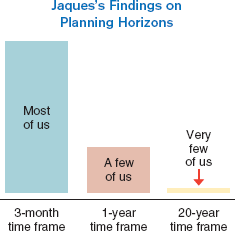
Plans at the top of the traditional organizational pyramid, the ones senior executives deal mainly with, tend to be more "strategic." By contrast, middle and lower level managers deal with plans that are more "tactical."
When top managers plan for the organization as a whole or a major component, the focus is on strategic plans. These are longer-term plans that set broad directions for an organization and create a framework for allocating resources for maximum performance impact. Strategic planning is part of the strategic management process discussed in the next chapter. It begins with a vision that clarifies the mission or purpose of the organization and expresses what it hopes to be in the future, and it involves determining the goals and objectives that will be pursued in order to accomplish that vision.
• A strategic plan identifies long-term directions for the organization.
• A vision clarifies the purpose of the organization and expresses what it hopes to be in the future.
Even though strategic plans and visions are long term, they are also dynamic. Consider the example of Skype, which began as an entrepreneurial start-up founded by Niklas Zennstrom and Janus Friis. Their vision was to connect people through Internet telephony.[466] And, it wasn't their strategic plan to just start the company, move it fast, and sell quickly to the highest bidder. Says Zennstrom: "Our objective was to build the business." Once started, however, Skype quickly gained millions of users, became an acquisition target, and was bought by eBay for $2.6 billion. The deal was sealed after Zennstrom and Friis had a breakthrough meeting with eBay's CEO at the time, Meg Whitman. According to Zennstrom, it was an Aha ! experience: "We went crazy on the whiteboard, mapping out ideas." But the realities of Skype's life within the eBay corporate umbrella didn't live up to the plan that brought the two firms together; the expected synergies didn't happen. When eBay finally sold the firm five years later at a loss, Skype's new private investors pledged to fulfill the founders' original vision by growing it again as an independent company dedicated to Internet telephony.
When a sports team enters a game or contest, it typically does so with a "strategy" in hand. Most often this strategy is set by the head coach in conjunction with assistants. The goal is clear: win the game or contest. As the game unfolds, however, situations arise that require actions to solve problems or exploit opportunities. They call for "tactics" that deal with a current situation in ways that advance the overall strategy for winning.
The same logic holds true for organizations. Tactical plans are developed and used to implement strategic plans. They specify how the organization's resources can be used to put strategies into action. In the sports context you might think of tactical plans as having "special teams" or as "special plays" ready to meet a particular threat or opportunity. In business, tactical plans often take the form of functional plans that indicate how different components of the enterprise will contribute to the overall strategy. Such functional plans might include:
• A tactical plan helps to implement all or parts of a strategic plan.
• Functional plans indicate how different operations within the organization will help advance the overall strategy.
Production plans —dealing with work methods and technologies.
Financial plans —dealing with money and capital investments.
Facilities plans —dealing with facilities and work layouts.
Logistics plans —dealing with suppliers and acquiring resource inputs.
Marketing plans —dealing with selling and distributing goods or services.
Human resource plans —dealing with building a talented workforce.
Operational plans guide behavior and describe what needs to be done in the short term to support strategic and tactical plans. They include standing plans like policies and procedures that are used over and over again, and single-use plans like budgets that apply to one specific task or time period.
• An operational plan identifies short-term activities to implement strategic plans.
A policy communicates broad guidelines for making decisions and taking action in specific circumstances. Organizations operate with lots of policies, and they set expectations for many aspects of employee behavior. Typical human resource policies cover things like employee hiring, termination, performance appraisals, pay increases, promotions, and discipline. For example, Judith Nitsch made sexual harassment a top priority when starting her engineering-consulting business.[467]
• A policy is a standing plan that communicates broad guidelines for decisions and action.
Nitsch defined a sexual harassment policy, took a hard line on its enforcement, and appointed both a male and a female employee for others to talk with about sexual harassment concerns.
Procedures describe rules for what actions are to be taken in specific situations. They are stated in employee handbooks and often called SOPs— standard operating procedures. Whereas a policy sets a broad guideline, procedures define precise actions to be taken. In the prior example, Judith Nitsch was right to establish a sexual harassment policy for her firm. But, she should also put into place procedures that ensure everyone receives fair, equal, and nondiscriminatory treatment under the policy. Everyone in her firm should know both how to file a sexual harassment complaint and just how that complaint will be handled.
• A procedure is a rule describing actions that are to be taken in specific situations.
Budgets are single-use plans that commit resources for specific time periods to activities, projects, or programs. Managers typically spend a fair amount of time bargaining with higher levels to get adequate budgets to support the needs of their work units or teams. They are also expected to achieve work objectives while keeping within the allocated budget. To be "over budget" is generally bad; to come in "under budget" is generally good.
• A budget is a plan that commits resources to projects or activities.
Managers deal with and use a variety of budgets. Financial budgets project cash flows and expenditures;operating budgets plot anticipated sales or revenues against expenses;nonmonetary budgets allocate resources like labor, equipment, and space. A fixed budget allocates a stated amount of resources for a specific purpose, such as $50,000 for equipment purchases in a given year. A flexible budget allows resources to vary in proportion with various levels of activity, such as having extra money available to hire temporary workers when workloads exceed certain levels.
Because budgets link planned activities with the resources needed to accomplish them, they are useful for tracking and controlling performance. But budgets can get out of control, creeping higher and higher without getting sufficient critical attention. In fact, one of the most common budgeting problems is that resource allocations get "rolled over" from one time period to the next without a rigorous performance review; the new budget is simply an incremental adjustment to the previous one. In a major division of Campbell Soups, for example, managers once discovered that 10% of the marketing budget was going to sales promotions no longer relevant to current product lines. A zero-based budget deals with this problem by approaching each new budget period as it if were brand new. In zero-based budgeting there is no guarantee that any past funding will be renewed; all proposals must compete for available funds at the start of each new budget cycle.
• A zero-based budget allocates resources as if each budget were brand new.
Note
✓Learning Check
Study Question 2
What types of plans do managers use?
Be sure you can ✓ differentiate between short-range and long-range plans ✓ differentiate between strategic and operational plans and explain how they relate to one another ✓ define policy and procedure and give examples of each in a university setting ✓ explain how zero-based budgeting works
The benefits of planning are best realized when the foundations are strong. Among the useful tools and techniques of managerial planning are forecasting, contingency planning, scenario planning, benchmarking, and the use of staff planners.
Who would have predicted on New Year's Eve 2008 that in 2009 General Motors and Chrysler would declare bankruptcy; that the U.S. government would own large shares of both firms; that GM's Pontiac and Saturn brands would be discontinued; and, that China would become the largest car market in the world?[468] Who among us was prepared—individually and organizationally—for the recent financial crisis well before it actually hit? GE's CEO Jeffrey Immelt is frank about his failure in this regard. "I should have done more to anticipate the radical changes that occurred," he says.[469]
Planning in business and our personal lives often involves forecasting, the process of predicting what will happen in the future.[470] News media regularly report forecasts of economic conditions, interest rates, unemployment, trade deficits, and more. Some are based on qualitative forecasting, which uses expert opinions to predict the future. Others involve quantitative forecasting, which uses mathematical models and statistical analyses of historical data and surveys to predict future events.
• Forecasting attempts to predict the future.
Though useful, all forecasts should be treated cautiously. They are planning aids, not substitutes. It is said that a music agent once told Elvis Presley: "You ought to go back to driving a truck, because you ain't going nowhere." He was obviously mistaken, and that's the problem with forecasts. They rely on human judgment—and they can be wrong.
Picture the scene. A professional golfer is striding down the golf course with an iron in each hand. The one in her right hand is "the plan"; the one in her left is the "backup plan." Which club she uses will depend on how the ball lies on the fairway. One of her greatest strengths is being able to adjust to the situation by putting the right club to work in the circumstances at hand.
Planning is often like that. By definition it involves thinking ahead. But the more uncertain the planning environment, the more likely that one's original forecasts and intentions may prove inadequate or wrong. The golfer deals with this by having backup clubs available. This amounts to contingency planning that identifies alternative courses of action that can be implemented if circumstances change. A really good contingency plan will even contain "trigger points" to indicate when to activate preselected alternatives. Given the uncertainties of our day, this is really an indispensable tool for managerial and personal planning.
• Contingency planning identifies alternative courses of action to take when things go wrong.
The lack of adequate contingency planning was very much in the news when debates raged over the massive oil spill from a BP offshore well in the Gulf of Mexico. Everyone from the public at large to U.S. lawmakers to oil industry experts criticized BP not only for failing to contain the spill quickly, but also for failing to anticipate and have contingency plans in place to handle such a disaster. For its part, a BP spokesperson initially said: "You have here an unprecedented event ... the unthinkable has become thinkable and the whole industry will be asking questions of itself." On the other hand, an industry expert responded: "There should be a technology that is pre-existing and ready to deploy at the drop of a hat ... it shouldn't have to be designed and fabricated now, from scratch."
After experiencing the full brunt of the crisis, BP CEO Tony Hayward finally admitted: "There are some capabilities that we could have available to deploy instantly, rather than creating as we go."[471] The lesson here is hard-earned but very clear. Contingency planning can't prevent crises like this from occurring. But whenever acting in an environment of risk and uncertainty, it's essential to have good contingency plans available to help deal with crises if and when they do happen.
A long-term version of contingency planning, called scenario planning, involves identifying several alternative future scenarios or states of affairs that may occur. Plans are then made to deal with each scenario should it actually happen.[472]
• Scenario planning identifies alternative future scenarios and makes plans to deal with each.
Scenario planning typically involves discussions of both "worst case" and "best case" scenarios. A worst case scenario in respect to global resource planning, for example, is outright conflict where nations fight one another to secure increasingly scarce supplies of oil. A best case is where nations work together to find ways to meet current resource needs while supporting the sustainability of global resources. At Royal Dutch/Shell, scenario planning began years ago when top managers asked themselves: "What will Shell do after its oil supplies run out?" Although such planning can never be inclusive of all future possibilities, it can help executives to really think ahead and better prepare for "future shocks."[473]
Planners sometimes become too comfortable with the ways things are going and overconfident that the past is a good indicator of the future. It is often better to keep challenging the status quo and not simply accept things as they are. One way to do this is through benchmarking, or the use of external and internal comparisons to better evaluate one's current performance and identify possible ways to improve for the future.[474]
• Benchmarking uses external and internal comparisons to plan for future improvements.
The purpose of benchmarking is to find out what other people and organizations are doing very well, and then plan how to incorporate these ideas into one's own operations. It is basically a way of learning from the successes of others. One benchmarking technique is to search for best practices —things people and organizations do that help them achieve superior performance.
• Best practices are things people and organizations do that lead to superior performance.
Well-run organizations emphasize internal benchmarking that encourages members and work units to learn and improve by sharing one another's best practices. They also use external benchmarking to learn from competitors and non-competitors alike. Xerox, for example, has benchmarked L.L. Bean's warehousing and distribution methods, Ford's plant layouts, and American Express's billing and collections. Ford benchmarked BMW's 3 series because, says James D. Farley, Ford's global marketing head, "The ubiquity of the 3 series engenders trust in every part of the world, and its design always has a strong point of view."[475] And in the apparel industry, the Spanish retailer Zara has become a benchmark for excellence in "fast-fashion."[476] The firm's design and manufacturing systems allow it to get new fashions from design to stores in two weeks. Zara produces only in small batches that sell out and create impressions of scarcity. Shoppers know they have to buy now because an item will not be replaced. And if something doesn't sell at Zara, it's not a big problem; there wasn't a large stock of the item to begin with.
As organizations grow, so do the planning challenges. Cisco Systems, for example, has been planning for quite some time that a lot of its growth will come from investments overseas. And it wasn't too long ago that China was the big target in Asia. It still is a big one, but when Cisco's planners analyzed their planning premises and projected future scenarios, India emerged as a strong competitor. It turns out that they found a lot to like about India: excellence in software design, need for Cisco's products, and weak local competition. They also found some major things to worry about in China, including a government favoring local companies and poor intellectual property protection.[477]
In many organizations, as with Cisco, staff planners are employed to help coordinate and energize planning. These specialists are experts in all steps of the planning process, as well as in the use of planning tools and techniques. They can help bring focus and expertise to a wide variety of planning tasks. But one risk is a tendency for a communication gap to develop between the staff planners and line managers. Unless everyone works closely together, the resulting plans may be based on poor information. Also, people may lack commitment to implement the plans, no matter how good they are.
Note
✓Learning Check
Study Question 3
What are some useful planning tools and techniques?
Be sure you can ✓ define forecasting, contingency planning, scenario planning, and benchmarking ✓ explain the benefits of contingency planning and scenario planning ✓ describe pros and cons of using staff planners
In a book entitled Doing What Matters, Jim Kilts, the former CEO of Gillette, quotes an old management adage: "In business, words are words, promises are promises, but only performance is reality."[478] The same applies to plans—plans, we might say, are words with promises attached. These promises are only fulfilled when plans are implemented so that their purposes are achieved. The implementation of plans is largely driven by solid management practices discussed throughout the rest of this book, from organizing to leading to controlling. But, the foundations for successful implementation begin with the processes of goal setting, goal alignment, and participation and involvement.
In the dynamic and highly competitive technology industry, CEO T. J. Rodgers of Cypress Semiconductor Corp. values both performance goals and accountability. He supports a planning system where employees work with clear and quantified work goals that they help set. He believes this helps people find problems before they can interfere with performance. Says Rodgers: "Managers monitor the goals, look for problems, and expect people who fall behind to ask for help before they lose control of or damage a major project."[479]
Commitment to goals isn't unique among successful managers; in fact, it's standard practice. When Jim Kilts took over as CEO of Gillette he realized that the firm needed work.[480] In analyzing the situation, however, he was very disciplined in setting planning goals to deal with high priority problems. In respect to sales, Gillette's big brands were losing sales to competitors. Kilts made plans to increase market shares for these brands. In respect to earnings, the company had missed its estimates for 15 quarters in a row. Kilts made plans to meet earnings estimates and raise the company's stock price.
Although both Rodgers and Kilts make us aware of the importance of goal setting in management, they may make it look a bit too easy. The way goals are set can make a big difference in how well they do in pointing people in the right directions and inspiring them to work hard. One thing to remember is the importance of moving from having "no goals" or even just everyday run-of-the-mill "average goals" to having really "great goals"—goals that result in plans being successfully implemented. Great goals tend to have these characteristics.
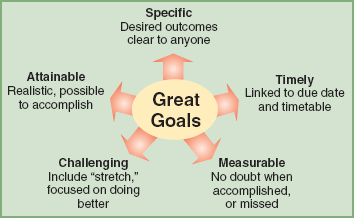
Specific —clearly target key results and outcomes to be accomplished
Timely —linked to specific timetables and "due dates"
Measurable —described so results can be measured without ambiguity
Challenging —include a stretch factor that moves toward real gains
Attainable —although challenging, realistic and possible to achieve
It is one thing to set great goals and make them part of a plan. It is quite another to make sure that goals and plans are well integrated across the many people, work units, and levels of an organization as a whole. Goals set everywhere in the organization should ideally help advance its overall mission or purpose. Yet, we sometimes work very hard to accomplish things that simply don't make much of a difference in organizational performance. This is why goal alignment is an important part of managerial planning.
• In a hierarchy of goals or hierarchy of objectives, lowerlevel goals and objectives are means to accomplishing higherlevel ones.
Figure 8.2 shows how a hierarchy of goals or hierarchy of objectives helps with goal alignment. When such a hierarchy is well defined, the accomplishment of lower-level goals and objectives is the means to the accomplishment of higher-level ones. The example in the figure is built around quality goals in a manufacturing setting. Strategic goals set by top management cascade down the organization step by step to become quality management objectives for lower levels. Ideally, everything works together in a consistent "means-end" fashion so that the organization, as stated in the figure, consistently performs as "the world's number one supplier of recyclable food containers."
Conversations between team leaders and team members or between supervisors and subordinates at each step in the hierarchy are essential to achieving the integration just described. Ideally, the conversations result in agreements on (1) performance objectives for a given time period, (2) plans through which they will be accomplished, (3) standards for measuring whether they have been accomplished, and (4) pro-cedures for reviewing performance results. Some-times this process is called management by objectives (MBO), but it is really just old-fashioned good management.[481]
As pointed out earlier, goal alignment conver-sations should focus on objectives that are specific, timely, measurable, challenging, and attainable. An example is the improvement objective for a team member "to reduce quality rejects by 10% within three months." Another is the personal development objective "to learn by April 15 the latest version of our supply chain management software package."
One of the more difficult aspects of stating performance objectives is the need to make them as measurable as possible. Ideally, there is agreement on a measurable end product, for example, "to reduce travel expenses by 5% by the end of the fiscal year." But performance in some jobs, particularly managerial ones, can be hard to quantify. Rather than abandon the quest for a good objective in such cases, it is often possible to agree on verifiable work activities. Their accomplishment serves as an indicator of performance progress. An example is "to improve communications with my team in the next three months by holding weekly team meetings." Whereas it can be difficult to measure "improved communications," it is easy to document whether the "weekly team meetings" have been held.

When 7-Eleven executives decided to offer new upscale products and services, such as selling fancy meals-to-go, they learned a planning lesson the hard way. Although their ideas sounded good at the top, franchise owners balked at the store level. The executives belatedly realized the value of taking time to involve the owners when making new plans for the stores.[482]
Planning is a process and not an event. And "participation" and "involvement" are two of its core components. Participatory planning includes in all planning steps the people who will be affected by the plans and asked to help implement them. One of the things that research is most clear about is that when people participate in setting goals they gain motivation to work hard to accomplish them.[483] Whether the planning is for a team, a large division, or the entire organization, involving people goes a long way toward gaining their commitments to work hard and support the implementation of plans.
• Participatory planning includes the persons who will be affected by plans and/or those who will implement them.
This role of participation and involvement in the planning process is shown in Figure 8.3, and there are many benefits when and if it can be followed in practice. Participation can increase the creativity and information available for planning. It can also increase the understanding and acceptance of plans, as well as commitment to their success. And even though participatory planning takes more time, it can improve results by improving implementation.
Note
✓Learning Check
Study Question 4
How can plans be well implemented?
Be sure you can ✓ list the criteria of great goals ✓ describe the value of a hierarchy of objectives ✓ give examples of improvement and personal development objectives ✓ explain how goal alignment can take place between a team leader and team members


